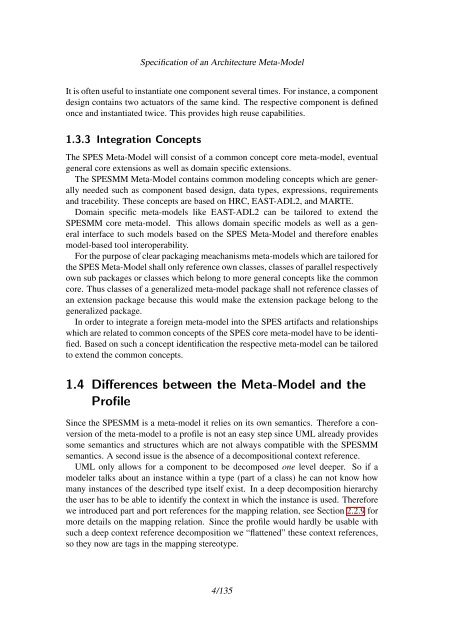Specification of an Architecture Meta-Model - SPES 2020
Specification of an Architecture Meta-Model - SPES 2020
Specification of an Architecture Meta-Model - SPES 2020
You also want an ePaper? Increase the reach of your titles
YUMPU automatically turns print PDFs into web optimized ePapers that Google loves.
<strong>Specification</strong> <strong>of</strong> <strong>an</strong> <strong>Architecture</strong> <strong>Meta</strong>-<strong>Model</strong><br />
It is <strong>of</strong>ten useful to inst<strong>an</strong>tiate one component several times. For inst<strong>an</strong>ce, a component<br />
design contains two actuators <strong>of</strong> the same kind. The respective component is defined<br />
once <strong>an</strong>d inst<strong>an</strong>tiated twice. This provides high reuse capabilities.<br />
1.3.3 Integration Concepts<br />
The <strong>SPES</strong> <strong>Meta</strong>-<strong>Model</strong> will consist <strong>of</strong> a common concept core meta-model, eventual<br />
general core extensions as well as domain specific extensions.<br />
The <strong>SPES</strong>MM <strong>Meta</strong>-<strong>Model</strong> contains common modeling concepts which are generally<br />
needed such as component based design, data types, expressions, requirements<br />
<strong>an</strong>d tracebility. These concepts are based on HRC, EAST-ADL2, <strong>an</strong>d MARTE.<br />
Domain specific meta-models like EAST-ADL2 c<strong>an</strong> be tailored to extend the<br />
<strong>SPES</strong>MM core meta-model. This allows domain specific models as well as a general<br />
interface to such models based on the <strong>SPES</strong> <strong>Meta</strong>-<strong>Model</strong> <strong>an</strong>d therefore enables<br />
model-based tool interoperability.<br />
For the purpose <strong>of</strong> clear packaging meach<strong>an</strong>isms meta-models which are tailored for<br />
the <strong>SPES</strong> <strong>Meta</strong>-<strong>Model</strong> shall only reference own classes, classes <strong>of</strong> parallel respectively<br />
own sub packages or classes which belong to more general concepts like the common<br />
core. Thus classes <strong>of</strong> a generalized meta-model package shall not reference classes <strong>of</strong><br />
<strong>an</strong> extension package because this would make the extension package belong to the<br />
generalized package.<br />
In order to integrate a foreign meta-model into the <strong>SPES</strong> artifacts <strong>an</strong>d relationships<br />
which are related to common concepts <strong>of</strong> the <strong>SPES</strong> core meta-model have to be identified.<br />
Based on such a concept identification the respective meta-model c<strong>an</strong> be tailored<br />
to extend the common concepts.<br />
1.4 Differences between the <strong>Meta</strong>-<strong>Model</strong> <strong>an</strong>d the<br />
Pr<strong>of</strong>ile<br />
Since the <strong>SPES</strong>MM is a meta-model it relies on its own sem<strong>an</strong>tics. Therefore a conversion<br />
<strong>of</strong> the meta-model to a pr<strong>of</strong>ile is not <strong>an</strong> easy step since UML already provides<br />
some sem<strong>an</strong>tics <strong>an</strong>d structures which are not always compatible with the <strong>SPES</strong>MM<br />
sem<strong>an</strong>tics. A second issue is the absence <strong>of</strong> a decompositional context reference.<br />
UML only allows for a component to be decomposed one level deeper. So if a<br />
modeler talks about <strong>an</strong> inst<strong>an</strong>ce within a type (part <strong>of</strong> a class) he c<strong>an</strong> not know how<br />
m<strong>an</strong>y inst<strong>an</strong>ces <strong>of</strong> the described type itself exist. In a deep decomposition hierarchy<br />
the user has to be able to identify the context in which the inst<strong>an</strong>ce is used. Therefore<br />
we introduced part <strong>an</strong>d port references for the mapping relation, see Section 2.2.9 for<br />
more details on the mapping relation. Since the pr<strong>of</strong>ile would hardly be usable with<br />
such a deep context reference decomposition we “flattened” these context references,<br />
so they now are tags in the mapping stereotype.<br />
4/135
















